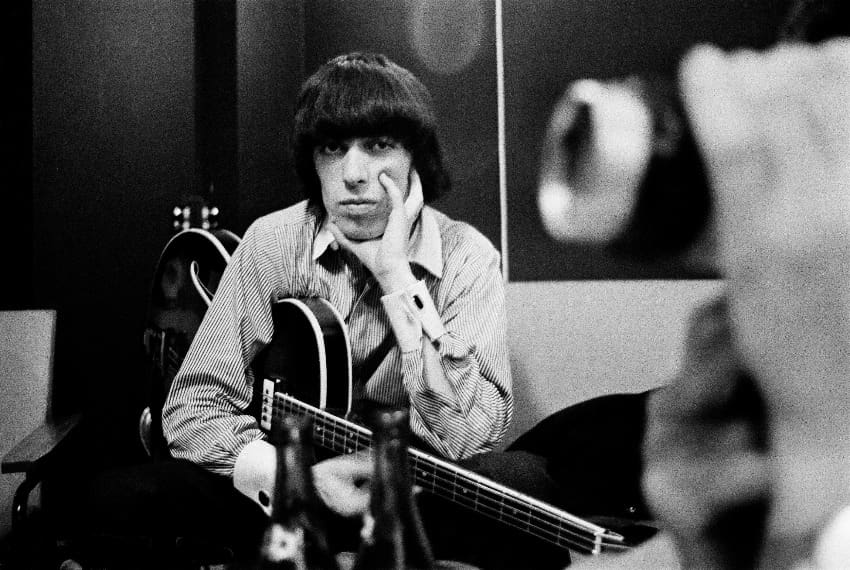
If you were to ask people who their favorite Rolling Stone is, you already know what to expect. A lot of “Micks,” maybe just as many “Keiths,” maybe a few “Charlies” depending on how unique the person you’re asking wants to seem.
But writer-director Oliver Murray’s new documentary, The Quiet One, suggests another possibility: original bassist, Bill Wyman. Born William George Perks, Wyman provided the heartbeat in Stones’ classics like “Gimme Shelter” and “Brown Sugar,” but he hasn’t played with the band since 1993, when he quit after a comeback world tour to live a normal family life in the south of France. And while that decision maybe makes him one of the band’s less glamorous figures, as the film goes on, it becomes clear that his levelheadedness and lack of vanity are precisely what makes him so fascinating.
Indeed, the first thing we see isn’t Wyman’s time in the band, but him in the present day, bent over a desk in a dimly-lit basement. The room is filled with bric a brac from Wyman’s life. The camera glides past dozens of pins of the band’s iconic lips logo, gig posters, film and audio recordings. As Wyman explains in voice-over, his penchant for collecting came from his grandmother. At first, his habit of keeping things from his own life seems to border on hoarding–and maybe it is–but it’s also allowed Wyman to become the band’s official archivist and Murray and his crew use his collection to their advantage.
Though the film is filled with interviews with Wyman and other famous musicians like Eric Clapton and producer Glyn Johns, what makes it so compelling is the way it uses Wyman’s archive to tell the story of his life. When he talks about the fact his father never complimented his music to his face, we see footage Wyman took of his father lounging on the grass on a warm day. When he talks about how crazy the fans used to get and how easy that made it to pick up women, we see shots taken through Wyman’s hotel windows of fans gathered below. Best of all, though, are the moments when the camera in present day shows us a garment Wyman once wore and we suddenly cut to an interview or a picture where Wyman he’s wearing it, as if the garment itself remembers it.
Much like Apollo 11 earlier this year, The Quiet One is first and foremost, a feat of assemblage. Wyman may have done a fine job documenting his own life, but there are inevitable gaps and editor Anne Perri helps fill them in. As Wyman describes his youth during World War II, the mix of images from news reels and other films that convey the experiences he describes give us a sense of what it was like to live it. When Wyman talks about how devastated he was when founding member Brian Jones drowned, we see home videos Wyman took of Jones during tours or lounging around during recording sessions.
However, while the behind the scenes footage we see of the Stones throughout is impressive, fans who come to the film looking for a little dirt on the other band members or their music will likely be disappointed. Indeed, while Murray inevitably spends a bulk of the film on Wyman’s time with the Stones, sound editor Jon Clarke only rarely includes their iconic music in the sound mix. We hear the band during performances or recording footage, but mostly we hear their regular voices in press interviews Wyman recorded, like an interview where Mick struggles to answer a question about a gig and then when Wyman jumps in with his archivist’s memory of events, Mick gently ribs him for it.
That said, Murray’s whole point is to put a spotlight on Wyman and it’s his life outside of the band that’s most interesting. While his bandmates were being arrested for drug use, Wyman avoided drugs because as he explains it, “the emptiness beneath me terrifies me.” Instead, while Mick Jagger and wife Bianca were partying at Studio 54, Wyman was spending time at his country homes in Britain and France with his son. And while he made great music with the Stones, he also had a successful solo career (his biggest hit being, “Je suis un rock star”), recorded with personal heroes like blues musician, Howlin’ Wolf and formed the Rhythm Kings years after he left the Stones.
Of the members of The Rolling Stones, former bassist Bill Wyman doesn’t seem like an obvious choice to be the subject of a documentary. He didn’t do drugs or drink much and he chose to leave the band for no other reason than he was ready to leave. But what The Quiet One does is show just how unique and remarkable someone so levelheaded and normal is in the music industry. He was surrounded by the glamor of fame but he decided to separate himself from it because, as Mary Wilson, lead singer of The Supremes notes, Wyman, “played his music for himself.” Murray and others suggest that Wyman simply lacks the ego and while that assessment might seem generous for a person whose most famous song is about being a rock star, consider this: when Wyman met Ray Charles (whom he calls his “favorite musician of the 21st Century), his response to the singer’s offer to have him play on Charles’s next album was that he was, “not good enough.”

